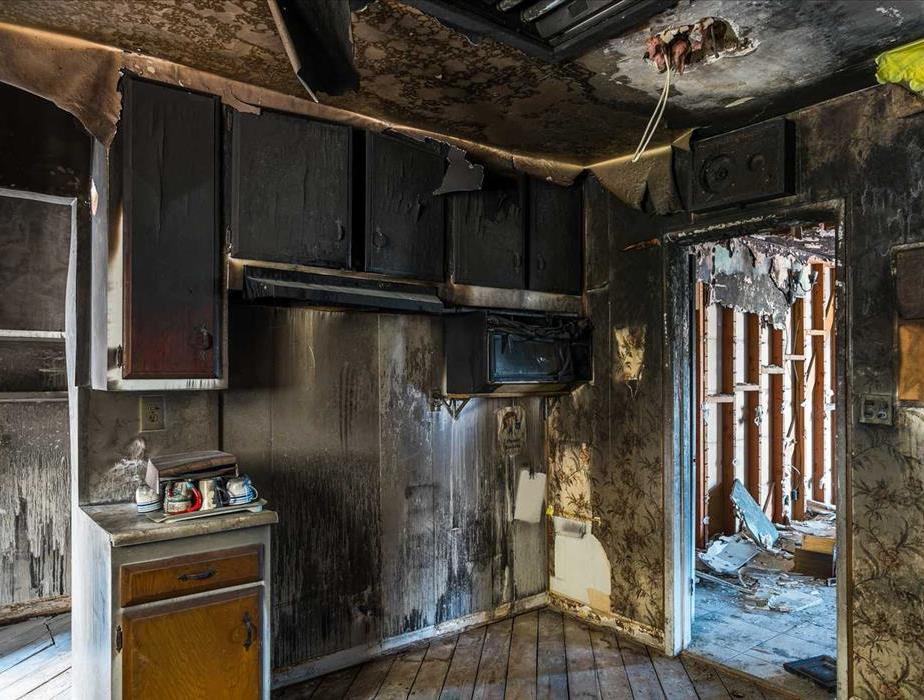Recent Posts
Fire Prevention Tips: Simple Steps for Safer Homes
4/21/2025 (Permalink)
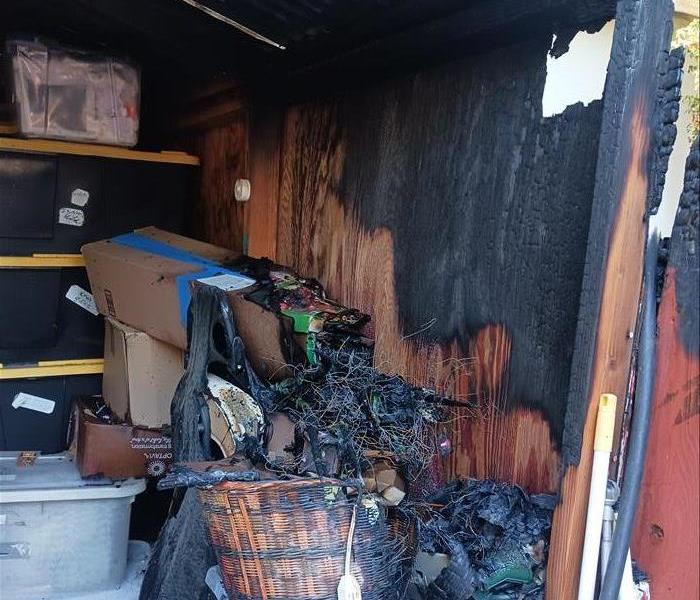 shed had a fire spread
shed had a fire spread
While some fires are caused by unavoidable circumstances, many can be prevented with a few proactive habits. Here are fire safety tips, inspired by the National Fire Protection Association (NFPA), to help keep your home or workplace safe:?? Stay alert in the kitchen
Never leave food unattended while frying, grilling, or broiling. Keep kids away from the stove unless they’re closely supervised.?? Use space heaters responsibly
Keep them at least three feet away from anything flammable—curtains, bedding, furniture, etc.?? Smoke safely—or better yet, outside
If you smoke, do it outside. If you must smoke indoors, use a sturdy ashtray and never smoke in bed.?? Keep matches and lighters out of kids' reach
Store them in high places, preferably with a child-proof lock.?? Inspect cords regularly
Frayed, damaged, or loose electrical cords should be replaced immediately to prevent electrical fires.?? Candle with care
Always place candles at least one foot away from anything flammable, and extinguish them before leaving the room or going to sleep.House fires can happen fast—but a little caution can go a long way. And if the unexpected does happen, remember:SERVPRO(818.881.3636) is just a phone call away.
Tips To Prevent Water Damage At Home
4/21/2025 (Permalink)
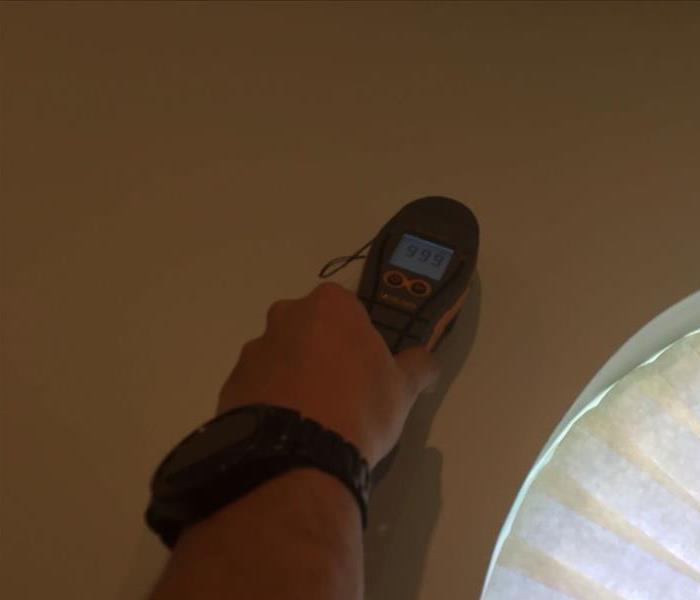 High moisture reading on the wall due to excessive water damage.
High moisture reading on the wall due to excessive water damage.
While not all water-related disasters are avoidable, many common issues can be prevented with routine maintenance and a little foresight. Here are some practical tips to help protect your property from unwanted water damage:?? Know where your main water shut-off valve is
In the event of a leak or burst pipe, turning off your water quickly can significantly reduce damage.?? Check appliances regularly
Inspect washing machines, dishwashers, and water heaters for worn hoses, rust, or leaks. Replace old hoses every 5 years—or sooner if needed.?? Clean gutters and downspouts
Clogged gutters can lead to roof leaks and water pooling around your foundation. Make sure water flows away from your home.?? Test your sump pump
If you have a basement, a working sump pump can be a lifesaver during heavy rain. Test it periodically, especially before storm season.?? Inspect your roof
Damaged shingles or flashing can allow rain to seep into your attic or ceilings. Have your roof checked yearly, especially after storms.?? Seal cracks and gaps
Caulking windows, doors, and foundation cracks can help keep out moisture and prevent mold growth.Water damage can escalate quickly—but a fast response can make all the difference. When in doubt, give SERVPRO of Tarzana/Reseda a call. We’re here 24/7, ready to make it “Like it never even happened.” Call us anytime at 818.881.3636
Why SERVPRO is Your Best Choice for Mold Remediation
3/6/2025 (Permalink)
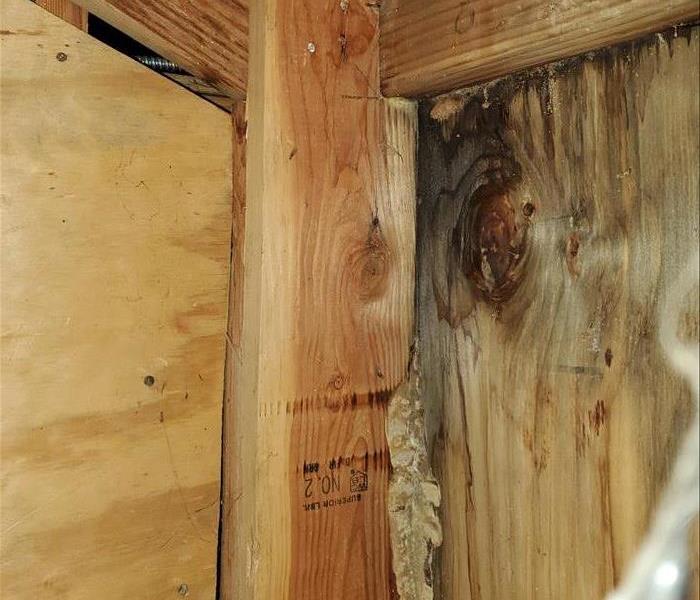 Visible mold growth on a wall, often caused by excess moisture from leaks or high humidity, which can lead to property damage and health concerns.
Visible mold growth on a wall, often caused by excess moisture from leaks or high humidity, which can lead to property damage and health concerns.
We’re Trained, Equipped, and Ready to Tackle Your Mold Problem
When mold becomes an issue, you need a trusted partner who can handle it with professionalism and expertise. SERVPRO of Tarzana and Reseda is here to guide you through every step of the mold remediation and restoration process. We collaborate closely with your insurance provider to restore your property to its pre loss condition quickly and efficiently.
Why SERVPRO?
At SERVPRO, we are committed to providing high-quality service you can rely on. Our goal is simple: to protect your property, support your well-being, and help with your financial recovery. We understand how stressful mold issues can be, which is why our team is dedicated to delivering reliable and effective remediation while minimizing disruption to your life.
Whether your mold issue is due to water damage, flooding, or high humidity, SERVPRO of Tarzana and Reseda offers thorough, professional service. We are available 24/7, 365 days a year for emergency services, and we provide no-obligation consultations and free estimates.
With over 23 years of experience, property managers, businesses, and homeowners trust SERVPRO of Tarzana and Reseda for mold remediation and cleaning services. We handle both small and large issues with care, ensuring your property is restored to its original condition.
Call SERVPRO of Tarzana and Reseda Today
If you're dealing with mold or need expert cleaning services, don’t wait—contact SERVPRO of Tarzana and Reseda for fast, reliable, and professional service. From emergency mold remediation to routine cleaning, we’re here to help. Let us make your mold problem "Like it never even happened."
Experiencing Water Loss? SERVPRO is Here to Help!
2/4/2025 (Permalink)
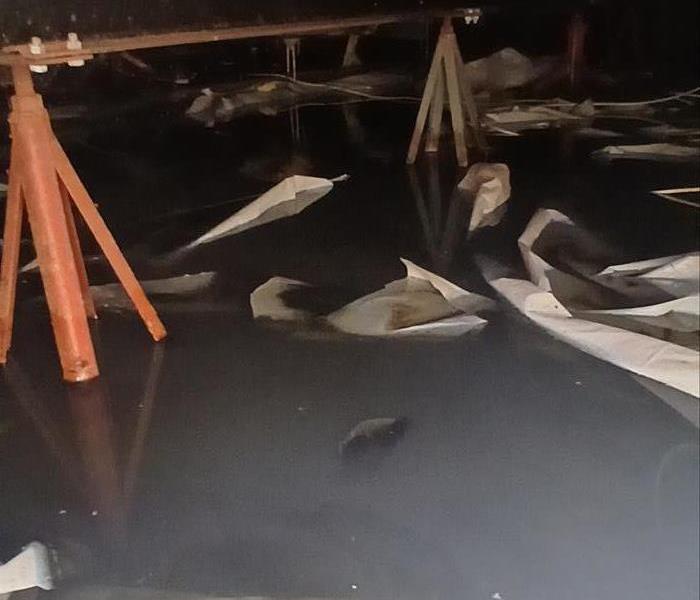 The photo shows a water-damaged crawlspace with standing water, damp insulation, and visible moisture damage on the beams and flooring.
The photo shows a water-damaged crawlspace with standing water, damp insulation, and visible moisture damage on the beams and flooring.
Water loss can occur unexpectedly, whether it's from a burst pipe, appliance failure, or flooding. If left untreated, water damage can lead to mold growth, weakened structures, and costly repairs. SERVPRO is here to provide expert water damage restoration and get your property back to normal quickly.
Why Choose SERVPRO for Water Loss Restoration?
- 24/7 Emergency Response: Water damage doesn’t wait for business hours. SERVPRO is available 24/7 to respond to your emergency and begin restoration right away.
- Fast Water Extraction: Using advanced equipment, we quickly remove standing water to minimize damage and prevent further issues.
- Thorough Drying & Dehumidification: Our powerful drying equipment ensures all moisture is removed from affected areas, preventing mold and structural damage.
- Comprehensive Restoration Services: From cleaning and sanitizing to repairing and replacing damaged structures, we handle every aspect of the restoration process to make it "Like it never even happened."
Signs of Water Loss You Should Watch For
Water damage can sometimes be subtle. Here are some common signs to look out for:
- Water stains on ceilings, walls, or floors
- Musty odors or visible mold growth
- Damp or warped carpeting and flooring
- Increased humidity in your home
Why Fast Action Matters
The quicker you act, the less damage you’ll face. Water can cause extensive harm in a short time, especially when it soaks into walls, floors, and furniture. Delaying cleanup can lead to mold, structural weakening, and higher restoration costs. Contact SERVPRO as soon as you notice water damage.
Fast Action for Storm Damage – SERVPRO of Tarzana/Reseda is Here to Help
1/3/2025 (Permalink)
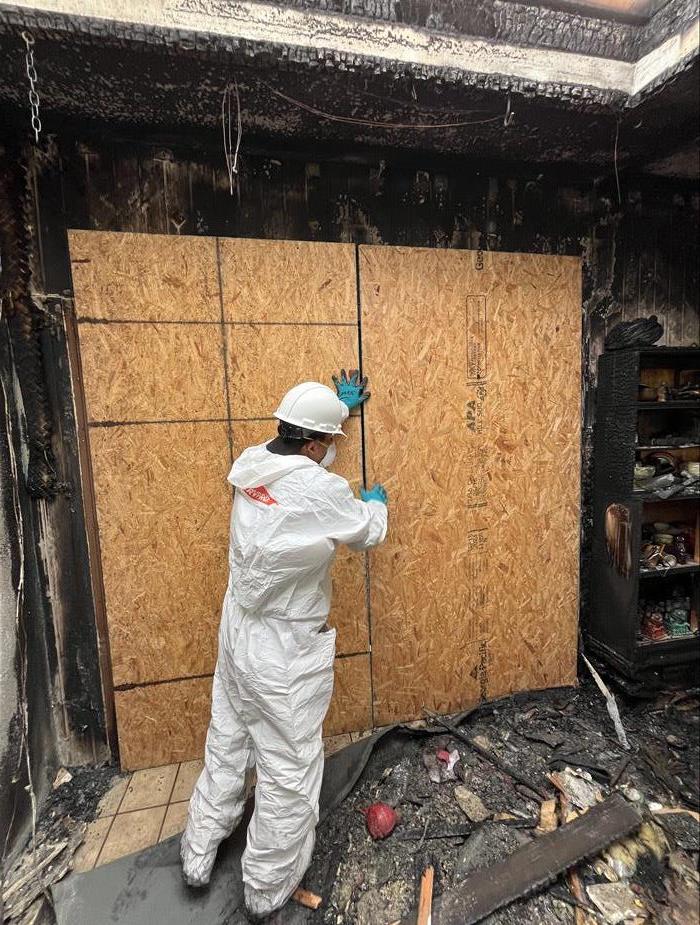 This board-up service is often one of the first steps taken in the storm recovery process, allowing SERVPRO to prevent further damages
This board-up service is often one of the first steps taken in the storm recovery process, allowing SERVPRO to prevent further damages
When storm damage strikes, the quicker you reach out to SERVPRO®, the sooner our technicians can arrive to evaluate the situation. We typically begin the mitigation process immediately to prevent further damage to your home or business. It’s important to remember that your insurance company requires you to take prompt action to limit additional damage and restore your property. SERVPRO is Here to Help® you through this process, ensuring your property is protected and assisting you with storm recovery every step of the way.
Types of Residential Storm Damage We Handle:
- Flooding
- Roofing and exterior damage
- Wildfire damage
- Fallen trees and wind damage
- Fallen power lines
- Scattered debris
- Hail damage
At SERVPRO of Tarzana/Reseda, our storm damage restoration emergency response teams are ready to assess the damage to your home or office. We’ll communicate our findings and recommendations to your insurance adjuster and begin the necessary repairs quickly to minimize your property’s downtime.
The safety and security of your property are our top priority, and we take immediate action to address any level of damage. Our mitigation process may include the following services:
- Temporary power generation
- Tree removal
- Roof tarping services
- Water extraction and mitigation
- Board-up services
When it comes to storm damage, speed is critical. The faster the mitigation process begins, the better your chances are of minimizing extensive damage. Don’t hesitate to call SERVPRO of Tarzana/Reseda for prompt, professional service you can trust. We’re here to make it "Like it never even happened."
Surviving a House Fire: Why Professional Restoration is Crucial
12/20/2024 (Permalink)
Surviving a House Fire: Why Professional Restoration is Crucial
A house fire is a traumatic event that can leave lasting physical and emotional scars. Beyond the immediate danger, the aftermath often presents hidden challenges that homeowners may not fully understand.
Why DIY Cleanup is a Dangerous Detour
Many homeowners, driven by a desire to quickly return to normalcy, are tempted to tackle the cleanup themselves. However, this is strongly discouraged.
- Safety First: Smoke and soot residue can contain harmful toxins. Attempting to clean without proper protective gear and specialized equipment can expose you to serious health risks.
- Hidden Dangers: Fire damage can extend beyond the obvious. Structural integrity may be compromised, electrical systems could be damaged, and hidden hazards like unstable materials or hazardous fumes may lurk within.
- Irreversible Damage: Prolonged exposure to smoke and soot can cause irreversible damage to your belongings. Metals corrode, plastics discolor, and even fabrics can become permanently stained.
The Importance of Swift Professional Action
Time is of the essence when it comes to fire damage restoration.
- Minimize Further Damage: Prompt action by professionals like SERVPRO of Tarzana/Reseda can significantly minimize the extent of damage. They have the expertise and specialized equipment to quickly address the situation and prevent further deterioration.
- Protect Your Investment: Delaying professional restoration can lead to escalating costs. As time passes, the damage worsens, making repairs more complex and expensive.
Don't Wait: Contact SERVPRO® Today
If you've experienced a house fire, prioritize your safety and contact SERVPRO of Tarzana/Reseda immediately. Our team of experienced professionals is available 24/7 to assess the situation, develop a customized restoration plan, and guide you through the recovery process.
Mold in Vacation Rentals: Ensuring Guest Safety
7/16/2024 (Permalink)
Vacation rentals offer travelers a home away from home, providing comfort, convenience, and relaxation during their stay. However, the presence of mold in vacation rentals can turn a dream vacation into a nightmare potentially putting guests in danger and tarnishing the reputation of rental properties. Mold growth in vacation rentals is often the result of moisture issues, inadequate ventilation, and improper maintenance. As such, ensuring guest safety and satisfaction requires proactive measures to prevent mold contamination and maintain a healthy indoor environment. In this blog, we'll explore the importance of addressing mold in vacation rentals and discuss strategies for ensuring guest safety.
Understanding the Risks of Mold in Vacation Rentals
Mold thrives in damp, humid environments, making vacation rentals susceptible to contamination, especially in coastal areas, humid climates, and properties with poor ventilation. Mold growth not only compromises indoor air quality risk but also can pose risk in your vacation rental. Additionally, mold infestations can lead to property damage, unpleasant odors, and negative reviews from guests, impacting the reputation and profitability of rental properties.
Importance of Preventive Maintenance
Preventive maintenance is crucial for preventing mold growth and maintaining a healthy indoor environment in vacation rentals. Property owners and managers should implement the following measures to address moisture issues and minimize the risk of mold contamination:
- Regular Inspections: Conduct regular inspections of vacation rentals to identify signs of water damage, leaks, and mold growth. Inspect areas prone to moisture accumulation, such as bathrooms, kitchens, basements, and laundry rooms, for signs of mold or water intrusion.
- Prompt Repairs: Address water leaks, plumbing issues, and moisture problems promptly to prevent mold growth. Repair roof leaks, fix leaking pipes, seal cracks and gaps, and address drainage issues to prevent water infiltration and moisture buildup.
- Proper Ventilation: Ensure adequate ventilation in vacation rentals to promote airflow and reduce humidity levels. Install exhaust fans in bathrooms and kitchens, use dehumidifiers in humid climates, and encourage airflow by opening windows and doors when weather permits.
- Humidity Control: Monitor indoor humidity levels regularly using hygrometers or humidity sensors. Maintain indoor humidity levels below 60% to inhibit mold growth and create an inhospitable environment for mold spores.
Guest Education and Communication
Effective communication with guests is essential for ensuring their safety and satisfaction during their stay in vacation rentals. Property owners and managers should:
- Provide Information: Provide guests with information about mold prevention, indoor air quality, and proper maintenance practices. Include information in rental agreements, welcome packets, and guest manuals to educate guests about potential risks and preventive measures.
- Encourage Reporting: Encourage guests to report any signs of water damage, leaks, or mold growth during their stay. Provide contact information for property management or maintenance staff and assure guests that their concerns will be addressed promptly and professionally.
- Respond Promptly: Respond to guest reports of mold or moisture issues promptly and take appropriate action to address the problem. Implement swift mitigation and remediation efforts to remove mold contamination, dry affected areas, and restore a healthy indoor environment for guests.
Professional Remediation and Maintenance
In cases of severe mold contamination or recurring moisture problems, professional remediation and maintenance services may be necessary to ensure guest safety and satisfaction. Certified mold remediation specialists like SERVPRO of Tarzana/Reseda have the expertise, equipment, and resources to conduct thorough inspections, remediate mold contamination, and implement preventive measures to protect vacation rentals and their occupants.
Mold in vacation rentals poses significant risks to guest safety and satisfaction, as well as the reputation and profitability of rental properties. By prioritizing guest safety and implementing effective mold prevention strategies, property owners and managers can ensure a positive guest experience and uphold the integrity of their vacation rental properties.
Water Damage from Appliances: Washing Machines, Dishwashers, etc.
6/12/2024 (Permalink)
Water damage can wreak havoc on your home, causing costly repairs and disruptions to your daily life. While natural disasters like floods often come to mind, many homeowners overlook the potential for water damage caused by everyday appliances. Among the culprits, washing machines and dishwashers stand out as common sources of household water damage. Understanding the causes and prevention methods can save you from headaches down the line.
Washing Machines
Your trusty washing machine can turn into a troublemaker if not properly maintained. Over time, wear and tear on hoses and fittings can lead to leaks. Additionally, improper loading or unbalanced loads can cause the machine to vibrate excessively, potentially loosening connections and causing leaks.
Regularly inspect hoses for signs of wear, such as cracks or bulges, and replace them every few years as a preventive measure. Consider upgrading to braided stainless steel hoses, which are more durable and less prone to bursting compared to traditional rubber hoses. Be mindful of overloading the machine, and ensure it's on a level surface to minimize vibrations.
Dishwashers
Dishwashers offer convenience, but they can also pose a water damage risk if neglected. A common culprit is a faulty door seal, which can allow water to escape during the wash cycle and seep onto your kitchen floor. Clogged drains and damaged water supply lines are other potential sources of leaks.
Regularly inspect the door seal for signs of damage or deterioration, such as cracks or mold growth, and replace it promptly if needed. Keep the dishwasher filter clean and clear of debris to prevent drain clogs. Periodically check water supply lines for leaks or signs of corrosion, and replace them if necessary.
Prevention Tips
Let’s delve into some tips to prevent an issue from happening in the first place:
- Regular Maintenance: Schedule routine inspections of your appliances and address any issues promptly to prevent minor leaks from turning into major water damage.
- Upgrade Components: Consider upgrading hoses, fittings, and seals to more durable materials to reduce the risk of leaks and failures.
- Monitor Performance: Pay attention to any changes in your appliances' performance, such as unusual noises or leaks, and investigate the cause immediately.
- Install Water Detection Devices: Invest in water detection devices that can alert you to leaks or flooding, giving you the opportunity to take action before significant damage occurs.
By taking proactive steps to maintain your appliances and address potential issues promptly, you can minimize the risk of water damage in your home. Remember, prevention is key when it comes to protecting your property from the costly consequences of water damage. Stay vigilant, and enjoy peace of mind knowing your home is safeguarded against appliance-related disasters.
Document Restoration After Water Damage
4/25/2024 (Permalink)
Water damage can wreak havoc on your property, causing destruction to not just your furniture and electronics but also to your valuable documents. Whether it’s important legal papers, cherished photographs, or irreplaceable family heirlooms, the loss of such items can be devastating. However, with the right knowledge and professional assistance, it’s possible to salvage many of these items through document restoration services.
At SERVPRO®, we understand the importance of preserving your memories and critical documents. That’s why we offer comprehensive document restoration services to help you recover from water damage effectively. In this guide, we’ll discuss the steps involved in document restoration after water damage and how our services can make a difference.
Assessment and Inventory
The first step in document restoration is conducting a thorough assessment of the damage. Our team carefully inspects each document to determine the extent of the water damage and assesses the best course of action for restoration. Additionally, we create a detailed inventory of all damaged items to track the restoration process accurately.
Document Drying
Once the assessment is complete, the next step is document drying. We utilize advanced drying techniques such as freeze-drying and dehumidification to remove moisture from the documents effectively. These methods help prevent further damage and inhibit mold growth, ensuring the best possible outcome for your items.
Cleaning and Decontamination
After drying, the documents undergo a meticulous cleaning and decontamination process. Our skilled technicians use specialized equipment and solutions to remove contaminants, stains, and odors from the documents safely. This step is crucial for restoring the appearance and integrity of the items while ensuring they are safe for handling.
Digitization and Reproduction
In some cases, documents may be too damaged to restore fully. In such instances, we offer digitization and reproduction services to preserve the content digitally. Our state-of-the-art scanning equipment captures high-resolution images of the documents, allowing you to access them electronically. This not only safeguards the information but also provides convenient access to your documents anytime, anywhere.
Quality Assurance
Throughout the restoration process, we maintain strict quality assurance protocols to ensure the highest standards of workmanship. Our goal is to deliver restored documents that meet or exceed your expectations, providing you with peace of mind during the recovery process.
Water damage can be a traumatic experience, but with SERVPRO’s document restoration services, you can take proactive steps to salvage your valuable items. From assessment and drying to cleaning and digitization, our comprehensive approach ensures the best possible outcome for your documents. If you’re facing water damage, don’t hesitate to contact us for professional assistance. We’re here to help you restore what matters most.
Safely using and storing propane tanks
4/19/2024 (Permalink)
Welcome back to the SERVPRO® blog, where we prioritize your safety and provide valuable information to help you navigate various aspects of home maintenance. In this edition, we'll be addressing an important topic that often goes overlooked – the safe usage and storage of propane tanks. As trusted experts in property restoration and maintenance, we understand the significance of handling potentially hazardous materials responsibly.
The Importance of Propane Tank Safety
Propane is a versatile and efficient fuel source commonly used for heating, cooking, and powering various appliances. However, mishandling propane tanks can pose serious safety risks. To ensure your family's well-being and safeguard your property, it's crucial to follow proper safety guidelines.
Inspection and Maintenance
Regularly inspect your propane tank for any signs of damage, rust, or leaks. If you notice any issues, contact a qualified professional immediately to address the problem. Timely maintenance ensures the longevity of your tank and minimizes the risk of accidents.
Proper Transportation
When transporting propane tanks, secure them in an upright position. Ensure that the tank is well-ventilated and never leave it in an enclosed vehicle, especially during hot weather, as this can lead to pressure build-up.
Safe Storage
Store propane tanks in a cool, well-ventilated outdoor area, away from direct sunlight and heat sources. Keep them upright and on a stable surface, ensuring they are not prone to tipping over. Never store propane tanks indoors or in enclosed spaces.
Valve Protection
Always use the protective cap or collar on the tank's valve when not in use. This prevents accidental opening and potential gas leaks. In case of an emergency, familiarize yourself with the shut-off valve location and procedures.
Usage Guidelines
Follow the manufacturer's guidelines for your propane-powered appliances and never attempt to modify or repair the tank yourself. If you suspect a leak, turn off the gas supply, evacuate the area, and contact emergency services.
At SERVPRO, your safety is our top priority. By adhering to these guidelines for safely using and storing propane tanks, you can enjoy the benefits of this efficient fuel source without compromising the well-being of your loved ones or property. For more information on home safety and maintenance, stay tuned to our blog or contact your local SERVPRO team for expert advice. Your peace of mind is our commitment.






 24/7 Emergency Service
24/7 Emergency Service





